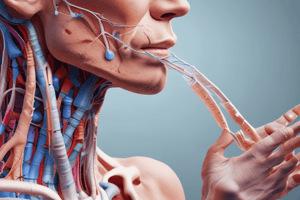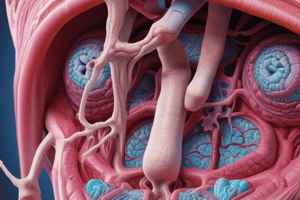Podcast
Questions and Answers
Quelle structure est responsable du passage de l'air du poumon vers l'espace pleural en cas de pneumothorax?
Quelle structure est responsable du passage de l'air du poumon vers l'espace pleural en cas de pneumothorax?
Quelle est la fonction des fosses nasales dans le système respiratoire?
Quelle est la fonction des fosses nasales dans le système respiratoire?
Quelle est la différence majeure entre les bronches principales droite et gauche?
Quelle est la différence majeure entre les bronches principales droite et gauche?
Quel est le rôle du mucus sécrété dans les fosses nasales?
Quel est le rôle du mucus sécrété dans les fosses nasales?
Signup and view all the answers
Quel cartilages est responsable de la saillie palpable sous la peau du cou?
Quel cartilages est responsable de la saillie palpable sous la peau du cou?
Signup and view all the answers
Où se situe la bifurcation trachéale?
Où se situe la bifurcation trachéale?
Signup and view all the answers
Quel est le principal muscle impliqué dans l'inspiration?
Quel est le principal muscle impliqué dans l'inspiration?
Signup and view all the answers
Quel orifice du diaphragme est entouré de muscles en forme d'épingle à cheveux?
Quel orifice du diaphragme est entouré de muscles en forme d'épingle à cheveux?
Signup and view all the answers
Quelle est la principale différence entre le poumon droit et le poumon gauche?
Quelle est la principale différence entre le poumon droit et le poumon gauche?
Signup and view all the answers
Quelle partie du poumon est responsable des échanges gazeux?
Quelle partie du poumon est responsable des échanges gazeux?
Signup and view all the answers
Quel orifice est limité par les piliers diaphragmatiques?
Quel orifice est limité par les piliers diaphragmatiques?
Signup and view all the answers
Quelle est la cause principale d'une déglutition réussie?
Quelle est la cause principale d'une déglutition réussie?
Signup and view all the answers
Quelle fonction du diaphragme permet l'expansion des poumons?
Quelle fonction du diaphragme permet l'expansion des poumons?
Signup and view all the answers
Quel est l'effet de la pression intra-pleurale sur l'expansion pulmonaire?
Quel est l'effet de la pression intra-pleurale sur l'expansion pulmonaire?
Signup and view all the answers
Study Notes
Module 5: Anatomie du Tronc Commun - Appareil Respiratoire
- Appareil Respiratoire: This module focuses on the respiratory system.
- Voies Aériennes Supérieures: The upper airway structures, including the nasal passages and oral cavity, are crucial for air intake.
- Fonction Nasale: The nasal passages warm, filter, and humidify inhaled air. They trap dust particles and serve a crucial role in respiration.
- Cavité Buccale: The oral cavity is involved in respiration, though less effectively than the nasal passages. Moisture from saliva is important.
- Origine de l'Appareil Respiratoire: The initial structures where air enters the respiratory system, including both the nasal and oral cavities.
- Relation Fosses Nasales – Sinus Aériens Faciaux: The nasal sinuses and air-filled spaces (sinuses) in the facial bones work together to increase surface area for humidification and filtering of air.
- Étage Cervical - Larynx: The larynx is a key component of the airway in the neck region. It is a complex structure of cartilages. Important for speech and swallowing.
- Cartilage Thyroïde: One of the largest cartilages forming a prominent projection in the throat (Adam's apple) in males.
- Cartilage Épiglottique: Involved in preventing food from entering the airway during swallowing.
- Cartilage Cricoïde: The ring-shaped cartilage forming a key part of the larynx structure.
- Étage Cervical - Trachée: The windpipe, which is part of the respiratory system.
- Structure Cartilagineuse: Trachea has C-shaped cartilages to prevent collapse.
- 2 Portions: The trachea is separated into cervical and thoracic portions.
- Étage Cervical - Carrefour Aéro-Digestif: Area where respiratory and digestive systems connect, vital for digestion and respiration.
- Mécanisme de la Déglutition: This discusses the complex process of swallowing and how it prevents food from entering the respiratory system.
- Étage Thoracique - Diaphragme: The primary muscle of respiration, separating the thoracic and abdominal cavities.
- Deux Coupoles: Diaphragm has two parts. Importantly, the diaphragm's position is crucial for respiration.
- Centre Tendineux: The central part of the diaphragm, crucial for its function.
- Partie Postérieure: The posterior part of the diaphragm where it attaches to the spine.
- Étage Thoracique - Poumons: The lungs are two spongy organs essential for respiration.
- 3 Faces: The lung has a medial face, a costal face (against the ribs), and a diaphragmatic face (against the diaphragm).
- Hile Pulmonaire: The entry point for the bronchi, blood vessels, and nerves into the lung.
- 3 Espaces Délimités: The lungs and thorax are separated by anatomical borders.
- Étage Thoracique - Voies Aériennes - Bronches Principales: Divisions of the trachea, distributing air to the lungs.
- Bronche Principale Droite/Gauche: The trachea branches into two main bronchi, one for each lung, and important for proper air distribution.
- Division: Details on branching patterns.
- Application Clinique: Practical application of anatomical knowledge related these structures.
- Étage thoracique - Voies Aériennes - Bronches Lobaires: Key divisions within the bronchi leading to specific lobes of each lung.
- Bronches Segmentaires et Bronchioles: Narrowing and branching of airways in the lungs.
- Alvéoles: Tiny air sacs in the lungs where gas exchange occurs.
- Système Alveolaire: Elaboration on functions.
- Étage Thoracique - Voies Aériennes - Plèvre: The thin lining surrounding the lungs, crucial for reducing friction during respiration.
- 2 Feuillet: The pleura has two layers, visceral (lung surface) and parietal (chest wall).
- Mouvements Observés Lors de l'Inspiration: The details on diaphragm and rib movements during breathing.
- Diaphragme and Rib Movements: The crucial and essential functions for breathing.
- Application Clinique - Pneumothorax: How air in the pleural space affects lung function.
- Médiastin: Anatomical structures between both lungs, containing vital organs.
Studying That Suits You
Use AI to generate personalized quizzes and flashcards to suit your learning preferences.
Related Documents
Description
Ce module aborde en détail l'appareil respiratoire, y compris les voies aériennes supérieures et leurs fonctions. Les passages nasaux, la cavité buccale et leur rôle dans la respiration sont également couverts. Il examine comment l'air est humidifié et filtré, ainsi que la relation entre les fosses nasales et les sinus faciaux.




